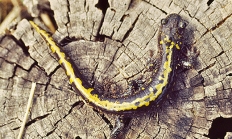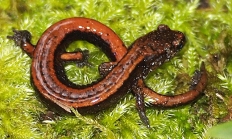Search myodfw.com
Highly adaptable, this ubiquitous species may be found in habitats as diverse as coastal marshes, sagebrush, shrub-steppe, and urban supermarket parking lots. The adult male is blackish, showing a purplish sheen on the head and a greenish sheen on his back. Its eyes are yellowish to creamy white. Females and juveniles are dusky brown above and grayish brown below, with paler throat and eyebrows, and brown eyes. The Brewer's blackbird is a common permanent resident along the coast. West of the Cascades it is common to abundant in inland valleys. Within the Cascades, they are a migrant and summer resident

Salamanders are a group of tailed amphibians with long bodies and short limbs. They often prefer habitats with damp conditions, which allows them to “breathe” better through their skin. Wet and rainy days (typically late fall through spring in Oregon) are the best time to look for salamanders, as the additional moisture from fog and rain allow for increased surface activity. To find salamanders, look in cracks or search under bark, rocks or logs. If you move any debris during your search, remember to put it back where you found it when you’re done—salamanders are sensitive to disturbance and many

Adult tiger salamanders are relatively large with olive-colored blotches outlined in black. They have gray undersides and can grow to 13 inches in total length. As adults, tiger salamanders live almost entirely on land, returning to the water to breed. Terrestrial adults spend a lot of time in burrows that they or other animals have dug. Tiger salamanders are found in grassland and shrub-steppe habitats. It is unknown whether tiger salamanders occurs naturally in Oregon, or whether they were introduced by people after larval salamanders used for bait colonized fishing lakes and ponds. Photo by Matt Reinbold, Flickr

These large-bodied salamanders have solid brown skin that is smooth and moist. Adults can grow to almost 10 inches in total length. Northwestern salamanders live in moist forests or partly wooded areas. Though common in Oregon, adult salamanders are rarely seen because they live underground. Terrestrial adults require moist crevices in logs or rodent burrows in the ground for shelter from weather and predators.

Appropriately named, adult long-toed salamanders have extremely long toes on their hind feet. Adults have black or brown skin that is smooth and moist with a yellow ragged-edged stripe running from its head to the tip of its tail. It is speckled with white or silver dots along its sides and underside. Adults may grow up to more than six inches in total length. Adult long-toed salamanders are seen infrequently, as they spend most of the year in the ground. They find cover in a variety of habitats including grasslands, dry shrub-steppe, pastures, lowland forests, high elevation lakes and ponds

These large salamanders are marbled brown and tan in color when in their rare terrestrial (land-living) adult form. They are brown with yellowish-tan patches on These large salamanders have an aquatic adult stage that is brown with yellowish-tan patches and short gills. The rare terrestrial adult is marbled brown and tan. Larvae of Cope’s giant salamander are smaller with a more narrow head and shorter legs than the coastal giant salamander. Both terrestrial and aquatic adults can grow up to eight inches in total length. Most adult salamanders live in cold, fast-flowing, clear and permanent streams in coniferous forests. Adult

Coastal giant salamanders are the largest salamanders in Oregon. Terrestrial adults are marbled with tan and brown and are mostly tan on their undersides. Larvae are brown with a large head, frilled gills, and a tail fin. Adults can grow to a total length of 14 inches. This species lives in dense wet forests near cold and clear streams, lakes, and ponds. Terrestrial adults are rarely seen because they spend most of their time in burrows. Occasionally, during times of heavy rain, adults are active on the forest floor. Photo by Steve Krause, NPS

These small salamanders have solid green- brown- or gray-colored sides and backs with bright yellow or orange undersides. Adults can grow to four inches in total length. Columbia torrent salamanders spend their lives in and near cold and clear water bodies including mountain streams, springheads, waterfalls and seeps in older forests. They need loose gravel stream beds for hiding and foraging. They are highly connected to their water sources, but in times of heavy rainfall, they may venture into a nearby forest. The Columbia torrent salamander is an Oregon Conservation Strategy Species in the Coast Range and Willamette Valley ecoregions

This small salamander is evenly speckled with dark flecks and has a brown head, back and tail with a bright yellow belly. Southern torrent salamanders spend their lives in and near permanent, cold and clear water bodies including mountain streams, springs and seeps in older coastal coniferous forests. For a salamander, they are able to tolerate relatively dry forest conditions. Southern torrent salamanders are Oregon Conservation Strategy Species in the Coast Range, Klamath Mountains and Willamette Valley ecoregions. Photo by John Clare, Flickr

The Cascade torrent salamander generally has numerous medium-sized black spots and white-gray flecking along its tan back and sides and a bright yellow belly that has fewer spots. Adults can grow to just over four inches in total length. Cascade torrent salamanders spend their lives in and near permanent, cold, fast-flowing and clear water including headwater streams, waterfall splash zones and seeps in older coniferous forests. Adults need gravel streambeds or other gravel areas with constant and shallow water flow for foraging and cover. The Cascade torrent salamander is an Oregon Conservation Strategy Species in the West Cascades and Willamette

Rough-skinned newts were named for their dry granular skin―most other salamander species have moist smooth skin. A terrestrial adult newt has a brown head and back with a bright orange belly and can grow to almost eight inches in total length. Rough-skinned newts have a powerful neurological poison in their skin and eggs to protect them from predators. A milky white substance is released from glands when disturbed. Avoid hand-to-mouth contact after handling a Rough-skinned newt. Through the non-breeding season, terrestrial adults live in forested areas along the coast and through to the eastern foothills of the Cascades. They find

This large woodland salamander is dark colored with a green- or tan- colored This large woodland salamander is dark colored with a green- or tan- colored stripe along its back. Dunn’s salamanders have no lungs and breathe entirely through their skin. Adults can grow to six inches in total length. Dunn’s salamanders live in the shaded rocky edges of highly humid forested streams and moist talus (rock fragment piles). They prefer areas that are permanently moist but not in flowing water. Adults often hide under rocks, in splash zones near streams and occasionally under woody debris. The rainy season of

The Larch Mountain salamander is one of the rarest amphibians in the Pacific Northwest. This small woodland salamander has a reddish-brown or yellow black-spotted stripe along its back and has a pink belly. The Larch Mountain salamander is one of the lungless salamanders that has to breathe through its skin. Mature adults can grow to four inches in total length. This salamander like’s steep basalt talus (piles of volcanic rock fragments). Forested areas are also important because trees block out sunlight, allowing moss to grow on rock piles which keeps the ground damp all year. Larch Mountain salamanders prefer slopes

The Western red-backed salamander is a woodland species and is small and slender. It has a wide stripe running from the head to the tip of the tail that can be yellow, orange, green or brown. Mature adults can grow up to just over four inches in total length. Western red-backed salamanders live in humid coniferous forests with mild winters. They find cover in rocky substrates, including talus (rock fragment piles), boulders and rock outcroppings. They may also hide under or in rotting logs, leaf litter and other forest debris. Like other woodland salamanders, this species breaths through its skin

Del Norte salamanders are solid brown or black in color. Some individuals, especially younger salamanders, have a reddish-orange to red stripe along their backs, but it generally fades as they mature. As the species’ scientific name suggests, individuals have long bodies in relation to their short limbs. The Del Norte salamander is one of the lungless salamander species that breathes through it’s skin. They can grow to six inches in total length. Del Norte salamanders live in older redwood or Douglas-fir forests and commonly use rocky substrates rubble, talus (rock fragment piles) and rock outcroppings for cover. During hot and

Siskiyou Mountains salamanders are similar to Del Norte salamanders, except they are a little shorter, growing to about five-and-a-half inches in total length. An adult salamander is brown with a light brown stripe along the back and a grayish-purple belly. It has light scattered flecks along the body. The Siskiyou Mountains salamander is a lungless salamander and breathes through its skin. Siskiyou Mountains salamanders require talus (rock fragment piles) or rock outcrops in older forests. This salamander retreats deep within rocky crevices that remain cool and moist during the dry summer. Even during the rainy season, Siskiyou Mountains salamanders typically

Ensatina salamanders are a lungless species with a short body and yellow or orange legs. There are two sub-species in Oregon: the Oregon ensatina ( E. e. oregonensis) is solid red, orange, brown or tan, while the painted ensatina ( E. e. picta) has small yellow, black or white spots on the back and tail. Ensatinas grow to just over four inches in total length. Ensatinas live in humid forests, woodlands and other areas with woody debris. They hide under logs, bark piles at the base of snags (standing dead trees), stumps and even woodpiles in residential areas for cover



May 8, 2025 Best bets for weekend fishing Trout fishing on the Wallowa River can be good throughout the spring months. Boats can now launch on Wallowa Lake, and spring can be some of the best times for kokanee fishing. Kinney Lake was stocked last fall and should have good numbers of trout going into the spring. Spring Chinook fishing is good on the lower Umatilla River. Trout stocking Stocked week of April 28-May 2: McNary Channel Ponds, Willow Creek Res, Anson Wright Pond, Morrow Co. OHV Park Pond #1, #2, #3, and #4, Cutsforth Pond, Hat Rock Pond, Bull
